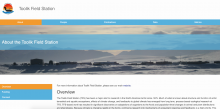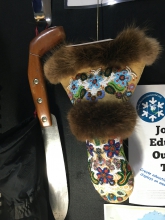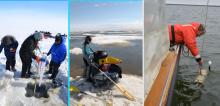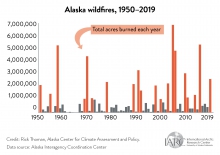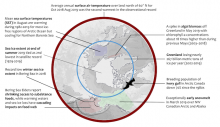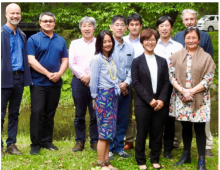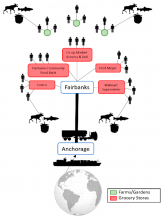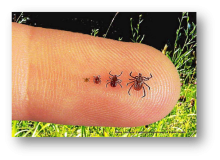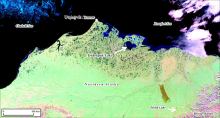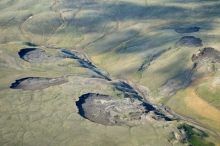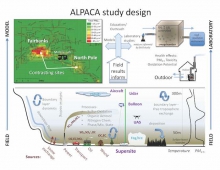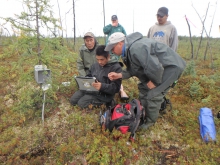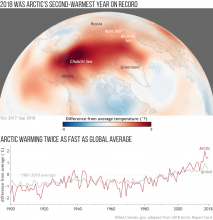Witness Community Highlights is an online publication launched in May 2017 to complement the regular publications of Witness the Arctic. It was developed in response to community feedback identifying the need for a monthly publication to highlight 1–2 Arctic research efforts and other timely items of interest to our readers. Community Highlights is distributed monthly via our Witness the Arctic mailing list of over 8,600 subscribers.
Arctic Data Center's New Customizable Portal Service
The new data portal allows users to create a curated collection of datasets from the Arctic Data Center by selecting data based on a particular region, taxa level, or keyword search—or a combination of any number of metadata characteristics present in the metadata of the Center's catalog. These dataset collections, as well as other related information, can be shared widely among a lab group or an interdisciplinary project via a customized URL. Several groups are making effective use of this new service.
By: Erin McLean, Community Engagement and Outreach Coordinator with the Arctic Data Center
US Arctic Research Commission Hosts Virtual Conference and Workshop
The Virtual Conference | COVID-19 Impacts in the Arctic, convened on 19 and 29 May 2020 by the U.S. Arctic Research Commission in partnership with the U.S. Naval War College and the Wilson Center's Polar Institute, hosted 10 moderated panel discussions involving an international group of 46 panelists. Discussion topics ranged from International Arctic Governance, to U.S. Coast Guard Arctic Operations, to the Arctic History of Viral Epidemics and Pandemics. Additionally, the Commission and the Alaska Center for Energy and Power co-hosted a free Virtual Alaska Electric Vehicle (EV) Workshop on 16 and 17 June 2020 to explore the technical and economic potential of EVs in Alaska and the Arctic.
By: Cheryl Rosa, Deputy Director and Anchorage-based Alaska Director of the United States Arctic Research Commission (USARC).
Winter Worlds Project Highlights the Wonders of Snow in Alaska and Beyond
"Our Winter World," is an NSF-funded Informal Science Learning project focused on snow. This outreach project has three components including snow-themed community science nights in Alaskan villages; the design and development of a traveling museum exhibition on snow; and research exploring how cultural background affects learning in museum settings.
By: Matthew Sturm, University of Alaska Fairbanks, Geophysical Institute, et al.
Tracking Alaskan Arctic Changes Through a Collaborative Network of Coastal Indigenous Communities
The Alaska Arctic Observatory & Knowledge Hub (AAOKH) provides sustained long-term observations of shifting environmental conditions in the Arctic. The primary goal of AAOKH is to provide northern Alaska coastal communities with the tools, resources, and scientific support to share their expertise through observations of changing coastal conditions and associated impacts to their access of traditional marine resources. Collectively, local observations provide a broad-scale and synoptic view of changing coastal sea ice and ocean conditions, and ultimately impacts at the community scale.
By: Donna D.W. Hauser, International Arctic Research Center (IARC) at Univ. of Alaska Fairbanks (UAF); Joshua Jones, IARC and the Geophysical Institute at UAF; Robert (Bobby) Puya Schaeffer, AAOKH Observer, Kotzebue, Alaska; Billy Adams, AAOKH Observer, Utqiaġvik, Alaska; Matthew L. Druckenmiller, National Snow and Ice Data Center at Univ. of Colorado Boulder; Roberta Tuurraq Glenn, graduate student at UAF; Elena Bautista Sparrow, IARC and Dept.of Natural Resources and Environment, at UAF; and Hajo Eicken, Director of IARC at UAF.
Long-Term Monitoring Program Sheds Light on High-latitude Landscape Response to Ongoing Warming
The University of Alaska Geophysical Institute Permafrost Laboratory manages an extensive network of permafrost monitoring sites across Alaska, Canada and Siberia. These long-term monitoring sites provide important baseline data that enable the research team to explore how ground temperature responds to ongoing climate change and lead to understanding future landscape response to ongoing warming and the potential implications for both the built and natural environment.
By: Louise Farquharson, Postdoctoral Researcher; Vladimir Romanovsky, Professor of Geophysics; Dmitry Nicolsky, Research Professional; and Alexander Kholodov, Research Associate; Geophysical Institute Permafrost Laboratory, University of Alaska Fairbanks
Indigenous Foods Knowledges Network: Facilitating Exchange between Arctic and Southwest Indigenous Communities on Food and Knowledge Sovereignty
The Indigenous Foods Knowledges Network brings together Indigenous scholars, practitioners, and community members and non-Indigenous scholars to exchange knowledge and experience in support of food sovereignty. Network gatherings include visits to community projects focusing on strengthening and revitalizing traditional foods and the lands and waters that sustain them, and innovating new ways of cultivating or harvesting healthy foods.
By: Noor Johnson, Research Scientist, National Snow and Ice Data Center, University of Colorado Boulder; Mary Beth Jäger, Research Analyst, Native Nations Institute, Udall Center for Studies in Public Policy at the University of Arizona; Lydia Jennings, PhD Candidate, Department of Soil, Water, and Environmental Science, University of Arizona; Amy Juan, Sovereign Remedies, LLC; Stephanie Russo Carroll, Assistant Research Professor, Native Nations Institute, Udall Center for Public Policy and Assistant Professor, Mel and Enid Zuckerman College of Public Health, University of Arizona; and Daniel B. Ferguson, Associate Research Scientist, Institute of the Environment, University of Arizona.
Long-Term Research Addresses Resilience of Beaufort Sea Lagoons
The NSF-funded the Beaufort Lagoon Ecosystems Long Term Ecological Research (BLE LTER) program addresses questions of ecosystem connectivity, stability, and resilience in an environment structured by highly dynamic and seasonally-driven physical forces, over seasonal and multi-decadal time scales, in six lagoons distributed across 500 kilometers of the northern Alaskan coastline.
By: Christina Bonsell, Project Manager, Beaufort Lagoon Ecosystems Long-Term Ecological Research Program
"MicroFEWs": Exploring the Impacts of Local Renewable Energy Projects on Remote Arctic Community Security and Resilience
Food, energy, and water are critical necessities for sustaining community health, well-being, and economic development. Reliance on fuel and energy can place remote Arctic communities in precarious situations where they are vulnerable to fluctuations in prices, energy subsidies, and supplies. The NSF-funded MicroFEWs project aims to explore the impact of local renewable energy projects on FEW security and resilience in the Arctic.
By: Jennifer Schmidt, Assistant Professor of Natural Resources Management and Policy University of Alaska Anchorage and Erin Whitney, Research Faculty, Data Collection and Analysis Program Manager, Solar Technologies Program Manager at the Alaska Center for Energy and Power
Alaska Fire Science Consortium Addresses Management Information Needs
The Arctic and boreal regions saw an active wildland fire season in 2019. In Alaska, wildland fire consumed more than 2.5 million acres, more than half the total acreage burned in the U.S. As climate change affects wildland fire regimes fire and land managers need current, specific, actionable science on a range of issues to support their decision-making. The Alaska Fire Science Consortium is one of 15 regional fire science exchanges supported by the federal Joint Fire Science Program to accelerate the awareness, understanding, and adoption of wildland fire science information by end users.
By: Alison York, Alaska Fire Science Consortium Coordinator
NOAA Arctic Report Card 2019: Brief Summary
Arctic Report Card 2019, an interagency and international publication coordinated by NOAA, was released on 10 December 2019. The peer-reviewed Arctic Report Card provides comprehensive summaries of key land, ice, ocean, and atmosphere observations made throughout the Arctic in the context of historical records and makes clear that Arctic ecosystems and communities are increasingly at risk due to continued warming and declining sea ice.
By: Jacqueline Richter-Menge, University of Alaska Fairbanks, Institute of Northern Engineering, Fairbanks, Alaska; Matthew Druckenmiller, National Snow and Ice Data Center, Boulder, Colorado; and Martin Jeffries, Cold Regions Research and Engineering Laboratory of the Engineer Research and Development Center, U.S. Army Corps of Engineers, Hanover, New Hampshire.
Development of UArctic's Thematic Network on Collaborative Resource Management
There is a growing urgency to learn more about ecosystem change and its impacts in the Arctic. In an effort to better leverage the knowledge of local experts, UArctic has newly established the Thematic Network on Collaborative Resource Management.
This network seeks to develop capacity in collaborative natural resource management and community monitoring in the Arctic and to support community-based approaches to gather information and its use to support management decisions.
By: Olivia A Lee, Assistant Research Professor, International Arctic Research Center, University of Alaska Fairbanks.
The Future Shape of the Greenland Geodetic Network
The Greenland Geodetic Network (GNET) is a series of global navigation satellite system (GNSS) installations located on the bedrock exposed around the perimeter of the island. The network initially aimed at observing the polar regions, predominantly through the use of GNSS and seismologic systems,this network maps vertical and horizontal movement of Greenland, over time, to help improve our understanding of ice-mass changes, allowing scientists to quickly detect and analyze any abrupt changes in the rate of ice loss in this region.
By: Robert Hawley, Associate Professor in Earth Sciences at Dartmouth College and Kelly Brunt, Associate Research Scientist with Earth System Science Interdisciplinary Center at the University of Maryland
Permafrost Discovery Gateway: A New Online Platform Supporting Knowledge-Generation from Big Imagery
The Permafrost Discovery Gateway (PDG), aimed at making big imagery permafrost information accessible and discoverable. New pan-Arctic data products will encompass relevant spatial (down to sub-meter) and temporal scales (down to daily) and provide easy access and discovery of these large datasets through visualization tools accessible through an interactive web browser which will enable knowledge-generation by researchers and the public.
By: Anna K. Liljedahl, Water and Environmental Research Center at the University of Alaska Fairbanks, et al
Widespread Permafrost Degradation in the Canadian High Arctic at 80°N
A recent study in the high Arctic finds widespread and rapid increases in active retrogressive thaw slumps that are a signs of permafrost instability. The study area is a polar desert landscape and is sensitive to small increases in summer air temperatures. Observations indicate that permafrost response to temperature here is complex and, although climate-initiated, terrain factors such as slope may become more important over time in determining slump activity and retreat rates.
By: Melissa Ward Jones, Department of Geography at McGill University
Working for Food Security in Interior Alaska
Reliable food supply is a central concern for residents of cities located in remote locations with extreme climate conditions. In a recent project, researchers examined how stake-holders in such northern cities ensure a high level of food security using a case study of the Fairbanks North Star Borough, Alaska, which is located in the interior of the state near the Arctic Circle. Through that work they hope to develop a prototype of a model that could be applied in other Arctic and near-Arctic cities.
By: Robert Orttung, George Washington University, Washington, D.C.
Tracking Ticks in Alaska: Understanding how an Invasive Species may Impact the Health of Humans and Animals in the Arctic
The effect of global environmental change on the distribution of species across the globe has been widely assessed. Invasive species do not stop at country borders. In Alaska, a new study is helping us understand if invasive ticks are being imported, and surviving, in the Last Frontier.
By: Micah Hahn, PhD, MPH, University of Alaska Anchorage, Institute for Circumpolar Health Studies and William George, MS Candidate; University of Alaska Anchorage
Re-establishing an Arctic Research Station at Teshekpuk Lake, Alaska
Arctic landscapes are responding to climate change, however long-term observation sites focused on landscape and ecosystem changes in the Arctic are extremely limited. For the past 12 years Ben Jones, University of Alaska Fairbanks, and colleagues have re-established the Teshekpuk research station in northern Alaska to address this need. They have combined renovation efforts with active and diverse research projects funded primarily by the National Science Foundation, U.S. Geological Survey (USGS), Bureau of Land Management, European Space Agency, and European Union.
By: Benjamin M. Jones, Water and Environmental Research Center, Institute of Northern Engineering, University of Alaska Fairbanks
A New and Exciting Age in Polar Science
"We are embarked on a new and exciting age in polar science; NSF, I am proud to say, is solidly committed to keeping the U.S. at the forefront of this new era ... It is clear today that changes in the polar regions affect the rest of the globe, and the need to understand and try to predict and even remediate those changes, has become a national and international priority." - Kelly K. Falkner, Director of the Office of Polar Programs, NSF
By: Kelly K. Falkner, Director of the Office of Polar Programs, National Science Foundation
Editor's note: This article was excerpted from a piece that originally appeared on 27 March 2019 in the journal Open Access Government.
Comparative Study Explores Northern Dene Astronomical Knowledge
The sky is routinely overlooked in Northern Dene (Athabaskan) ethnology as a meaningful site for investigating linguistic and cultural knowledge. The central research question of this study asked: How do Northern Dene peoples perceive, conceptualize, and integrate the sky and its contents into systems of knowledge and worldview? Results have shown that systems of stellar knowledge are especially complex and detailed.
By: Chris Cannon, Ph.D. student in Cultural Anthropology at the University of Alaska Fairbanks
A Remarkable Response of Ice-Rich Permafrost Terrain to Summer Warming
Thaw of permafrost containing high concentrations of ground ice can dramatically impact Arctic environments through resulting thermokarst features. Once exposed to melt, retrogressive thaw slumps, the most important type of thermokarst landform on sloping terrain, may reactivate every summer for up to 50 years—altering water quality and aquatic ecosystems, and liberating frozen organic carbon for subsequent decomposition, thereby contributing to the permafrost carbon feedback.
By: Antoni Lewkowicz, Department of Geography, Environment, and Geomatics at the University of Ottawa
Alaska NSF Program Releases Stakeholder Engagement Report
A recent study by Alaska NSF Established Program to Stimulate Competitive Research (EPSCoR) examined the capacity of different Northern communities to adapt to change. A key element of the project was directly engaging with community stakeholders to help shape the direction of the research, and to ensure that research outcomes met local needs. The subsequent report, "Sharing Questions, Sharing Answers" details strategies used by different parts of the project to engage stakeholders, and lessons learned along the way.
By: Tom Moran, Alaska NSF EPSCoR, Communications Manager
Novel Project Seeks Understanding of Air Pollution Processes in Arctic Conditions
Pollution in Arctic cities and near industrial areas can be quite severe and wintertime Arctic conditions differ greatly from the more-studied pollution problems during summertime in the more populated mid-latitude regions. The Alaskan Layered Pollution And Chemical Analysis (ALPACA) project seeks to close knowledge gaps in understanding of atmospheric chemical mechanisms occurring under cold and dark conditions.
By: William R. Simpson, Geophysical Institute and Department of Chemistry and Biochemistry, University of Alaska Fairbanks
2018 Arctic Observing Summit Meeting News
Members of the Arctic Observing Summit—Working Group on Implementation and Optimization met recently to gather input for a draft Task Team Scope of Work supporting Sustaining Arctic Observing Network—Committee on Networks objectives. The draft task statement addresses several areas, including how to develop a process that will generate strong international investments in Arctic observing and promote synergies and interoperability among observing efforts.
By: Sandy Starkweather, Executive Director of the U.S. Arctic Observing Network
Revised Principles for Conducting Research in the Arctic: 21st Century Guidelines to Ethical Research
The U.S. Interagency Arctic Research Policy Committee has completed the revision of the Principles for Conducting Research in the Arctic. These Principles provide guidelines for researchers to engage with people and conduct research in the Arctic. They cover a range of topics from creating a safe work environment, crediting and compensating collaborators, coordinating with local communities, learning about the history and culture of the region, data ownership, and limiting environmental impact.
By: Renee Crain Wagner, Arctic Research Support and Logistics (RSL) Program Manager at NSF; Amina Schartup, AAAS Science & Technology Policy Fellow hosted in the NSF Office of Polar Programs, Arctic Sciences Section; and Meredith LaValley, IARPC.
NOAA Arctic Report Card 2018: Brief Summary
The Arctic Report Card 2018, released on 11 December 2018, describes a range of land, ice, and ocean observations made throughout the Arctic. The report includes 14 essays written by more than 80 scientists from 12 countries. The collective content of the report makes clear that the continued warming of the Arctic atmosphere and ocean are driving broad change in the environmental system in predicted, and also unexpected, ways. The results reported show that the effects of persistent Arctic warming continue to mount.
By: Emily Osborne, National Oceanic and Atmospheric Administration, Arctic Research Program; Jacqueline Richter-Menge, University of Alaska Fairbanks, Institute of Northern Engineering; Martin Jeffries, Cold Regions Research and Engineering Laboratory of the Engineer Research and Development Center, U.S. Army Corps of Engineers


